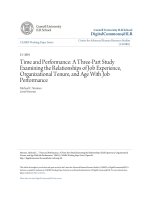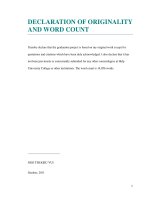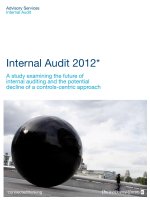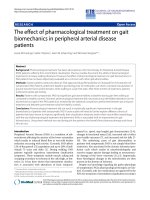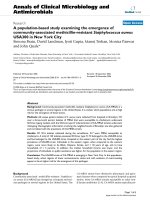An open-label study examining the effect of pharmacological treatment on mannitol- and exercise-induced airway hyperresponsiveness in asthmatic children and adolescents with exercise-induced
Bạn đang xem bản rút gọn của tài liệu. Xem và tải ngay bản đầy đủ của tài liệu tại đây (375.43 KB, 7 trang )
Török et al. BMC Pediatrics 2014, 14:196
/>
RESEARCH ARTICLE
Open Access
An open-label study examining the effect of
pharmacological treatment on mannitol- and
exercise-induced airway hyperresponsiveness in
asthmatic children and adolescents with
exercise-induced bronchoconstriction
Salome Schafroth Török1, Thomas Mueller1, David Miedinger1, Anja Jochmann1,2, Ladina Joos Zellweger1,
Sabine Sauter3, Alexandra Goll3, Prashant N Chhajed1, Anne B Taegtmeyer4, Bruno Knöpfli3 and Jörg D Leuppi5,6*
Abstract
Background: Mannitol- and exercise bronchial provocation tests are both used to diagnose exercise-induced
bronchoconstriction. The study aim was to compare the short-term treatment response to budesonide and
montelukast on airway hyperresponsiveness to mannitol challenge test and to exercise challenge test in children
and adolescents with exercise-induced bronchoconstriction.
Methods: Patients were recruited from a paediatric asthma rehabilitation clinic located in the Swiss Alps. Individuals
with exercise-induced bronchoconstriction and a positive result in the exercise challenge test underwent mannitol
challenge test on day 0. All subjects then received a treatment with 400 μg budesonide and bronchodilators as
needed for 7 days, after which exercise- and mannitol-challenge tests were repeated (day 7). Montelukast was then
added to the previous treatment and both tests were repeated again after 7 days (day 14).
Results: Of 26 children and adolescents with exercise-induced bronchoconstriction, 14 had a positive exercise
challenge test at baseline and were included in the intervention study. Seven of 14 (50%) also had a positive mannitol
challenge test. There was a strong correlation between airway responsiveness to exercise and to mannitol at baseline
(r = 0.560, p = 0.037). Treatment with budesonide and montelukast decreased airway hyperresponsiveness to exercise
challenge test and to a lesser degree to mannitol challenge test. The fall in forced expiratory volume in one second
during exercise challenge test was 21.7% on day 0 compared to 6.7% on day 14 (p = 0.001) and the mannitol challenge
test dose response ratio was 0.036%/mg on day 0 compared to 0.013%/mg on day 14 (p = 0.067).
Conclusion: Short-term treatment with an inhaled corticosteroid and an additional leukotriene receptor antagonist in
children and adolescents with exercise-induced bronchoconstriction decreases airway hyperresponsiveness to exercise
and to mannitol.
Keywords: Exercise-induced bronchoconstriction, Airway hyperresponsiveness, Children, Exercise challenge test,
Mannitol challenge test
* Correspondence:
5
Internal Medicine, Kantonal Hospital Baselland and University of Basel, Basel,
Switzerland
6
University Clinic of Internal Medicine, Kantonsspital Baselland, Liestal,
Switzerland
Full list of author information is available at the end of the article
© 2014 Török et al.; licensee BioMed Central Ltd. This is an Open Access article distributed under the terms of the Creative
Commons Attribution License ( which permits unrestricted use, distribution, and
reproduction in any medium, provided the original work is properly credited. The Creative Commons Public Domain
Dedication waiver ( applies to the data made available in this article,
unless otherwise stated.
Török et al. BMC Pediatrics 2014, 14:196
/>
Background
Airway hyperresponsiveness (AHR), a characteristic
feature of asthma, is an abnormal increase in airflow
limitation that follows exposure to a stimulus that would
be innocuous in a healthy person [1]. There are two
main types of bronchial provocation test (BPT): direct
and indirect tests. The direct airway challenges using
methacholine and histamine, have a direct effect on
smooth muscle cells that causes contraction and leads
to a narrowing of the airways [2]. The indirect tests
can be subdivided into physical stimuli such as exercise, eucapnic voluntary hyperventilation, cold air
hyperventilation, hypertonic saline and mannitol, and
the pharmacological agent adenosine monophosphate.
These indirect BPTs cause airflow limitation through
inducing a release of mediators from inflammatory
cells and sensory nerves. The mediators act on smooth
muscle cell causing contraction which results in airway
narrowing [2-4].
The exercise challenge test (ECT), an indirect BPT
is used to diagnose and assess exercise-induced
bronchoconstriction (EIB), which is a common manifestation of asthma, especially in childhood [5,6]. EIB is defined
as a transient increase in airway resistance that occurs after
vigorous exercise and is seen in 70% to 90% of individuals
with asthma and in approximately 11% of the general
population with no known asthma [7,8].
An indirect bronchial provocation test using dry
powder inhalation of mannitol has been developed by
Sandra Anderson in Australia [9]. In comparison to
many other BPT it is cheaper, portable and faster to
perform [2]. This new BPT leads to an increase in the
osmolarity of the airway surface leading to the release of
mediators from a variety of inflammatory cells [2]. In
vitro, mannitol causes a rapid release of histamine
from human lung mast cells, with the maximum release
occurring at two to three times physiological osmolarity.
Asthmatic subjects with airways responsiveness to
exercise and hypertonic saline have also been shown
to react to inhaled mannitol [10,11].
Both adults and children with current asthma can be
accurately identified using the mannitol challenge test
(MCT) [9,12]. In children, Subbarao has suggested
the MCT as a safe, faster and repeatable alternative
to a challenge test with methacholine [12]. In clinical
practice, mannitol challenge has been proven to be
both a sensitive and valid test for demonstrating the
effects of inhaled corticosteroids (ICS) in asthma and to
predict future asthma exacerbations [13,14]. Whether
MCT and/or ECT can detect a treatment response to ICS
and montelukast in children and adolescents with EIB is
not known.
The aim of the current study was therefore to compare treatment response to budesonide and additional
Page 2 of 7
montelukast as assessed by airway hyperresponsiveness to
exercise and to mannitol challenge tests in children and
adolescents with exercise-induced bronchoconstriction.
Methods
Study design
Twenty six children and adolescents with physician
diagnosed asthma were recruited from the Alpine
Children’s Hospital Davos (Switzerland). The study
was carried out according to the 1975 Declaration of
Helsinki (modified in 1983) and in adherence to local
guidelines for good clinical practice. The protocol was
approved by the local ethics review committee (Kanton
Graubünden Switzerland, reference number 21/07), and
written informed consent was obtained from all subjects’
parents or guardians.
During their stay in the hospital, all individuals underwent
a structured multimodal rehabilitation program.They
received an individually adapted physical activity program
with the aim of supporting fitness and motivating them to
include physical activity as part of their daily routine,
and encouraging them to maintain an active lifestyle on a
long-term basis. The daily exercise program focused on
endurance activities to improve aerobic performance.
Physical coordination and flexibility skills were also developed. A typical exercise session lasted 60 to 90 minutes,
was performed in groups and was supervised by exercise
therapists: for example in summertime 4 km walks or ball
games, in wintertime indoor swimming plus water games,
ice sports or snowboarding and an activity once per week
that involved 4–5 hours of either hiking (in summertime)
or 4–5 hours of downhill skiing (in wintertime). Other
activities included ergometric cycling.
Spirometry was measured at baseline and all patients
underwent ECT and MCT on two different days (day 0).
Children found to have a positive ECT were then subsequently included in the therapeutic monitoring part of the
study. Children received standard-treatment with 400 μg
budesonide per day and inhaled bronchodilators as needed
for 7 days, after which ECT and MCT were repeated
(day 7). Montelukast was added to the previous treatment
at the beginning of the second week and ECT and MCT
were repeated again after 7 days (day 14).
Subjects
Study inclusion criteria were children or adolescents
with physician diagnosed asthma. We excluded patients
if they had a pulmonary disease other than asthma, an
upper respiratory tract infection in the last 3 weeks or
an emergency department visit for treatment of asthma
within 1 month prior to the baseline visit. Patients were also
excluded from the study if they received methylxanthines,
cromoglycate, anticholinergics or antihistamines within
Török et al. BMC Pediatrics 2014, 14:196
/>
2 weeks or systemic corticosteroids within 1 month before
the first visit.
Spirometry
Spirometry was performed using American Thoracic Society criteria [15]. A spirometer (EasyOne™, ndd, Zurich,
Switzerland) was used to measure forced vital capacity
(FVC) and one second forced expiratory volume (FEV1).
Spirometry was performed until two repeatable values of
FEV1 within 100 ml were obtained. The higher of the
two repeatable FEV1 values was recorded and the percentage of predicted values was calculated [16].
Page 3 of 7
Statistical analysis
Continuous variables are expressed as mean ± standard
deviation (SD) or as medians with interquartile range
(IQR), and categorical variables were expressed as relative frequencies and percentages. Continuous variables
were compared by using non-parametric tests. For all
data analyses, we used the statistical software package
SPSS V.19 (SPSS Inc., Chicago, USA). A p-value of <0.05
was considered statistically significant. We calculated
the efficiency of the MCT to diagnose a significant drop
in FEV1 during exercise as follows: (true-positive results
[MCT and ECT positive] + true-negative results [MCT
and ECT negative])/number of subjects investigated.
Exercise challenge test
ECT was performed according to the ATS guidelines for
exercise challenge testing [17]. Briefly, ECT was performed using a treadmill with adjustable speed and
grade. Heart rate was monitored using a pulse oximeter.
Treadmill speed and grade were chosen to produce 4–6
minutes of exercise at near-maximum targets with a
total duration of exercise of 8 minutes. Spirometry was
performed before exercise and then serially at 2, 5, 10
and 15 min after cessation of exercise. Response to ECT
was positive when a fall in FEV1 of ≥15% after challenge
was reached.
Mannitol challenge test
MCT test was performed according to the protocol by
Anderson et al. which is further summarized elsewhere
[9]. Briefly, doses consisting of 0 (empty capsule acting
as a placebo), 5, 10, 20, 40, 80, 160, 160 and 160 mg of
mannitol were administered via an inhaler device (Pharmaxis Ltd., Frenchs Forrest, NSW, Australia). The 80
and 160 mg doses were given in multiples of 40 mg capsules. After the inhalation of each dose the patient was
told to hold their breath for five seconds. Two FEV1 maneuvers were performed 60 seconds after each dose and
the highest FEV1 measurement was recorded. The FEV1
value measured after the 0 mg capsule was taken as the
pre-challenge FEV1 and was used to calculate the percentage decrease in FEV1 in response to MCT. The challenge was stopped when a 15% fall in FEV1 was
documented or a cumulative dose of 635 mg had been
administered. Response–dose-ratio, which is an index of
activity (RDR =% of maximum fall in FEV1/maximum
dose mannitol given), was calculated for all subjects. The
provoking dose of mannitol to cause a 15% fall in FEV1
(PD15) was calculated by linear interpolation of the
relationship between the percent fall in FEV1 at the end
of the MCT test and the cumulative dose of mannitol
required (in mg) to provoke this fall. Response to MCT
was considered positive when a fall in FEV1 of ≥15%
occurred after a cumulative mannitol dose of 635 mg
or less.
Results and discussion
Baseline characteristics and correlation of MCT with ECT
Twenty-six children and adolescents (age 13.5 ± 2.7 years;
21 males) were included in the study. Of these 14 had a
positive response to the ECT and therefore proceeded to
the treatment part of the study. These 14 subjects (2 females and 12 males) were aged 9 to 20 years (14.1 ±
3.1 years) and had a mean body mass index (BMI) of
27.8 ± 8.8 kg/m2. Asthma had been known for a mean of
5.4 years (range 0 to 15 years). Three individuals were
current smokers.
Lung function at baseline was normal in all patients
with a mean FEV1 of 111% predicted (±16%) and a mean
FVC% of 115% predicted (±17%). Fourteen patients had
a positive ECT and therefore proceeded to optimized
treatment, their baseline characteristics and lung function are shown in detail in Table 1 where the results are
stratified according to the MCT outcome. Of these 14
ECT positive patients, 7 also had a positive MCT
(Table 2). There was high correlation between maximum
fall in FEV1 during exercise test and RDR (r = −0.560,
p = 0.037). Median drop in FEV1 during exercise in
patients with a positive MCT was higher than those with
a negative MCT but the difference was not statistically
significant (p = 0.286). As expected those with positive
MCT had a higher RDR to mannitol (p = 0.029).
Effect of treatment regimen on BHR to exercise and
mannitol
After seven days of inhaling 400 μg budesonide per day,
10 out of 14 subjects had become unresponsive to ECT,
while 1 out of 7 subjects had become unresponsive to
MCT and one individual became positive in the MCT
(Table 2).
After adding montelukast to the treatment regimen of
those four who had a positive ECT at day 7 three had
become unresponsive to ECT whereas one individual
had become responsive to ECT again. Five out of the
seven individuals who were responsive to MCT became
unresponsive, however the remaining two responsive
Török et al. BMC Pediatrics 2014, 14:196
/>
Page 4 of 7
Table 1 Baseline characteristics of the 14 participants with exercise induced bronchoconstriction
Subject
BMI (kg/m2)
Age
FEV1 (L)
FEV1%
predicted
FVC
(liter)
FEV1%
predicted
Max fall FEV1 RDR mannitol PD15
in ECT (%)
(%/mg)
mannitol
MCT positive
A
39.7
3.24
83.5
3.98
84.5
15.7
0.059
293
B
25.0
2.34
128.6
2.86
134.9
29.1
0.034
569
C
16.4
2.02
125.3
2.56
133.3
61.7
0.120
133
D
17.2
3.09
109.2
3.97
116.8
48.7
0.155
102
E
36.4
2.43
92.4
2.82
89.5
16.0
0.037
512
F
29.7
3.54
101.4
4.89
115.9
29.7
0.313
49
G
25.8
4.45
100
5.82
107.6
22.5
Mean ± SD or median (IQR) 25.8 (19.1)
14.1 ± 3.5 3.01 ± 0.83 105.8 ± 16.5 3.84 ± 1.20 111.8 ± 19.6 29.1 (32.7)
0.039
475
0.059 (0.118)
293 (410)
MCT negative
H
15.5
1.92
85.3
2.44
90.4
46.8
0.034
I
35.0
4.52
113.6
5.02
103.9
20.8
0.030
J
37.1
2.87
101.4
3.62
105.5
16.9
0.020
K
30.0
3.41
104.9
4.85
130
42.9
0.075
L
30.7
3.69
100.5
4.64
104.5
17.6
0.020
M
35.2
5.78
136.3
7.23
140.4
18.3
0.030
N
14.8
2.56
133.3
3.08
134.5
17.9
0
3.53 ± 1.29 110.8 ± 18.5 4.41 ± 1.57 115.6 ± 19
18.3 (25.3)
0.030 (0.014)
0.22
0.29
0.03
Mean ± SD or (Median)
30.7 (19.7)
p-value
0.45
14.1 ± 3
ns
0.24
0.31
0.45
ns = non significant.
individuals had a lower PD15 compared to their individual
PD15 at day 0 and day 7 (data not shown).
With asthma therapy consisting of budesonide for
14 days and additional montelukast for 7 days, maximum
fall in FEV1 after ECT decreased significantly (median drop
in FEV1 during exercise 21.7% (IQR 26.5%) on day 0,
11.9% (IQR 13.4%) on day 7 and 6.7% (IQR 8.7%) on day
14). Medians were significantly different between these
points in time (day 0 vs. day 7 p = 0.006, day 0 vs. day 14
p = 0.001 and day 7 vs. day 14 p = 0.045 (Figure 1).
Airway hyperresponsiveness to mannitol showed a
similar pattern; RDR in the MCT decreased between day
0 and day 14 (median RDR in MCT day 0: 0.036%/mg
(IQR 0.059%/mg), day 7: 0.021%/mg (IQR 0.027%/mg)
and day 14: 0.013%/mg (IQR 0.016%/mg), comparison of
means were as follows: change between day 0 and day 7:
p = 0.064, between day 0 and day 14: p = 0.064 and
between d7 and d14: p = 0.0167 (Figure 2).
There was a high correlation between the change in fall
of FEV1 during exercise when day 0 was compared with
day 14 and the change in RDR in the MCT between day 0
and day 14 (r = 0.538, p = 0.047, Figure 3).
This study shows that half of the asthmatic children and
adolescents with exercise-induced bronchoconstriction
also have bronchial hyperresponsiveness to mannitol.
A structured intervention during hospitalization for
pulmonary rehabilitation including a step-up treatment
with inhaled corticosteroids and a leukotriene inhibitor
decreases airway hyperresponsiveness to exercise and to
inhaled mannitol. Evidence exists that exercise itself
may positively influence airway hyperresponsiveness [18].
Whether the effect observed was caused by the pharmacological treatment or the structured exercise program cannot
be distinguished in our study. Another limitation of our
study may be the open-label design, which might have had
an involuntary effect on the challenge tests.
Not all of our patients with a loss of FEV1 during exercise
of greater than 15% also had a drop in FEV1 during MCT.
Our study supports the findings of Anderson et al. who
found a low sensitivity and specificity (59% and 65% respectively) of MCT to identify exercise induced bronchoconstriction in 509 children and adults [19]. This is in accordance
with a recent study in elite swimmers where Clearie and coworkers could not demonstrate an association between the
outcome of MCT and a sport specific exercise test [20].
Exercise and eucapnic voluntary hyperventilation
(EVH) are standardized tests to diagnose EIB. Indirect
challenge tests including testing with exercise, EVH,
mannitol or hypertonic saline cause the release of
endogenous mediators that cause the airway smooth
muscle to contract and the airways to narrow [21].
Holzer et al. compared the MCT with eucapnic hyperventilation (EHV) in elite summer sport athletes and reported a strong association between the responses to
Török et al. BMC Pediatrics 2014, 14:196
/>
Page 5 of 7
Table 2 Comparison of exercise (ECT) and mannitol (MCT)
challenge test results in 14 patients with exercise
induced bronchoconstriction
Day 0 (Baseline)
MCT positive
MCT negative
Total
ECT positive
7
7
14
ECT negative
0
0
0
Total
7
7
14
Efficiency of MCT for the diagnosis of a positive ECT = 50%
Day 7 (under budesonide therapy)
MCT positive
MCT negative
Total
ECT positive
2
2
4
ECT negative
5
5
10
Total
7
7
14
Efficiency of MCT for the diagnosis of a positive ECT = 50%
Day 14 (under budesonide and montelukast therapy)
MCT positive
MCT negative
Total
ECT positive
0
2
2
ECT negative
2
10
12
Total
2
12
14
Efficiency of MCT for the diagnosis of a positive ECT = 71%
these different challenges [22]. In their study 24 out
of 25 subjects with a positive EHV challenge also had a
positive mannitol challenge. Using the EVH challenge as
the gold standard for exercise-induced bronchoconstriction,
the mannitol challenge had a sensitivity of 96% and
specificity of 92% for identifying athletes with a positive
EVH. However during EVH individuals must inhale a
standardized dry gas in a controlled fashion and ventilation
is monitored in order to reach the target ventilation rate
and volume. For an exercise test, however, individuals need
to exercise on a treadmill or a bicycle while breathing dry
air and exercise intensity is monitored and guided by
measuring heart rate and not ventilation.
In our study population we could show an effect of antiinflammatory treatment with budesonide and montelukast
on airway hyperresponsiveness to exercise and mannitol.
Brannan and co-workers have shown that inhaled steroids
decrease reactivity in the MCT and Leuppi and co-workers
suggested that MCT can be used to predict treatment failure and exacerbation during step-down of asthma therapy
[13,14]. Investigating short-term effects of montelukast on
airway responsiveness to MCT, Anderson did not report a
decrease in sensitivity to mannitol but a faster recovery
from bronchoconstriction after MCT [23].
While we could show significant impact of treatment on
the ECT outcomes, we found only a trend towards
decreased reactivity in the MCT. There are several possible
explanations for this finding. The intervention period was
relatively short and is quite likely that ongoing treatment
with budesonide and montelukast could have further
decreased the patient’s sensitivity in the MCT. The relatively small sample size raises the concern that a type II
error has occurred and led to an insignificant result.
However, there was a significant correlation between the
treatment response of ECT and MCT. Most of the patients
Figure 1 Boxplot of fall in FEV1 during exercise challenge test at day 0, day 7 and day 14 in 14 individuals with exercise induced
bronchoconstriction.
Török et al. BMC Pediatrics 2014, 14:196
/>
Page 6 of 7
Figure 2 Boxplot of mannitol response dose ratio at day 0, day 7 and day 14 in 14 individuals with exercise induced bronchoconstriction.
who were included in this study were not living in the area
of the Alpine Children’s Hospital. Davos is known to be
the highest city in Europe located about 1560 meters
(5120 feet) above sea level in the Swiss Alps. One can
hypothesize that adaptation to the higher altitude as well
as the regular exercise as part of the rehabilitation program
led to a decrease in ventilation and thus the stimulus
during the ECT and therefore a lower sensitivity for the
diagnosis of exercise induced bronchoconstriction. However
we did not assess ventilation during ECT testing.
Limitations of the study are its observational design,
relatively small sample size as well as the absence of a
control group that underwent pharmacological treatment without concurrent training. Conclusions which
can be drawn from the study must therefore be made in
the light of these limitations.
Figure 3 Correlation of treatment response on MCT and ECT reactivity in 14 individuals with exercise induced bronchoconstriction
(r = 0.538, p = 0.047).
Török et al. BMC Pediatrics 2014, 14:196
/>
Conclusions
Children and adolescents with asthma and exercise
induced bronchoconstriction repeatedly underwent
challenge tests with exercise and mannitol. A multimodal
treatment concept including physical training and medical
treatment with an inhaled steroid and a leukotriene inhibitor resulted in a decrease in airway hyperresponsiveness
to both exercise and mannitol.
Abbreviations
AHR: Airway hyperresponsiveness; BPT: Bronchial provocation test;
ECT: Exercise challenge test; EIB: Exercise-induced bronchoconstriction;
EVH: Eucapnic voluntary hyperventilation; FEV1: One second forced
expiratory volume; FVC: Forced vital capacity; ICS: Inhaled corticosteroids;
MCT: Mannitol challenge test; ns: Non significant; IQR: Interquartile range;
RDR: Response–dose-ratio; PD15: Provoking dose of mannitol to cause a 15%
fall in FEV1; SD: Standard deviation.
Competing interests
The study was supported financially by a grant to the corresponding author
from Merck Sharp & Dohme AG, Switzerland, producers of Montelukast.
Merck Sharp & Dohme AG, Switzerland had no role in study design, data
collection and analysis, decision to publish, or preparation of the manuscript.
Authors’ contributions
JL, BK and TM made substantial contributions to conception and design of
the study. TM, SS and AG made substantial contributions to the acquisition
of data. SST, TM, DM, AJ, LJ, PC, BK and JL to analysis and interpretation of
data. SST, AJ and PC were involved in drafting the manuscript and AT in
revising it critically for important intellectual content. All authors read and
approved the final manuscript.
Acknowledgements
The use application for mannitol described in this study is covered by United
States Patient no. 5817028 and internationally by PCT/AU95/000086. The
patent is owned by Central Sydney Area Health Service, NSW, Australia and
is licensed to Pharmaxis Ltd, French Forrest, NSW, Australia.
Page 7 of 7
6.
7.
8.
9.
10.
11.
12.
13.
14.
15.
16.
17.
18.
19.
Author details
1
Internal Medicine, University Hospital Basel and University of Basel, Basel,
Switzerland. 2University Childrens Hospital Basel, Basel, Switzerland. 3Alpine
Childrens Hospital Davos, Davos, Switzerland. 4Clinical Pharmacology and
Toxicology, University Hospital Basel, Basel, Switzerland. 5Internal Medicine,
Kantonal Hospital Baselland and University of Basel, Basel, Switzerland.
6
University Clinic of Internal Medicine, Kantonsspital Baselland, Liestal,
Switzerland.
21.
Received: 5 May 2014 Accepted: 9 July 2014
Published: 2 August 2014
22.
References
1. Sterk PJ, Fabbri LM, Quanjer PH, Cockcroft DW, O’Byrne PM, Anderson SD,
Juniper EF, Malo JL: Airway responsiveness: standardized challenge
testing with pharmacological, physical and sensitizing stimuli in adults:
report working party standardization of lung function tests, European
community for steel and coal: official statement of the European
respiratory society. Eur Respir J Suppl 1993, 16:53–83.
2. Leuppi JD, Brannan JD, Anderson SD: Bronchial provocation tests: the
rationale for using inhaled mannitol as a test for airway
hyperresponsiveness. Swiss Med Wkly 2002, 132(13–14):151–158.
3. Anderson SD: Provocative challenges to help diagnose and monitor
asthma: exercise, methacholine, adenosine, and mannitol. Curr Opin Pulm
Med 2008, 14(1):39–45.
4. Leuppi JD: Bronchoprovocation tests in asthma: direct versus indirect
challenges. Curr Opin Pulm Med 2014, 20(1):31–36.
5. Haby MM, Anderson SD, Peat JK, Mellis CM, Toelle BG, Woolcock AJ: An
exercise challenge protocol for epidemiological studies of asthma in
children: comparison with histamine challenge. Eur Respir J 1994, 7(1):43–49.
20.
23.
Haby MM, Peat JK, Mellis CM, Anderson SD, Woolcock AJ: An exercise
challenge for epidemiological studies of childhood asthma: validity and
repeatability. Eur Respir J 1995, 8:729–736.
Anderson SD: Issues in exercise-induced asthma. J Allergy Clin Immunol
1985, 76(6):763–772.
Gotshall RW: Exercise-induced bronchoconstriction. Drugs 2002,
62(12):1725–1739.
Anderson SD, Brannan J, Spring J, Spalding N, Rodwell LT, Chan K, Gonda I,
Walsh A, Clark AR: A new method for bronchial-provocation testing in
asthmatic subjects using a dry powder of mannitol. Am J Respir Crit Care
Med 1997, 156:758–765.
Brannan JD, Anderson SD, Perry CP, Freed-Martens R, Lassig AR, Charlton B:
The safety and efficacy of inhaled dry powder mannitol as a bronchial
provocation test for airway hyperresponsiveness: a phase 3 comparison
study with hypertonic (4.5%) saline. Respir Res 2005, 6:144.
Brannan JD, Koskela H, Anderson SD, Chew N: Responsiveness to Mannitol
in asthmatic subjects with exercise- and hyperventilation-induced
asthma. Am J Respir Crit Care Med 1998, 158:1120–1126.
Subbarao P, Brannan JD, Ho B, Anderson SD, Chan HK, Coates AL: Inhaled
mannitol identifies methacholine-responsive children with active
asthma. Pediatr Pulmonol 2000, 29:291–298.
Brannan JD, Koskela H, Anderson SD, Chan HK: Budesonide reduces
sensitivity and reactivity to inhaled mannitol in asthmatic subjects.
Respirology 2002, 7:37–44.
Leuppi JD, Leuppi JD, Salome CM, Jenkins CR, Anderson SD, Xuan W, Marks
GB, Koskela H, Brannan JD, Freed R, Andersson M, Chan HK, Woolcock AJ:
Predictive markers of asthma exacerbation during stepwise dose-reduction
of inhaled corticosteroids. Am J Respir Crit Care Med 2001, 163:406–412.
American Thoracic Society: Standardization of spirometry, 1994 update.
Am J Respir Crit Care Med 1995, 152(3):1107–1136.
Weng TR, Levison H: Standards of pulmonary function in children. Am Rev
Respir Dis 1969, 99(6):879–894.
Crapo RO, Casaburi R, Coates AL, Enright PL, Hankinson JL, Irvin CG,
MacIntyre NR, McKay RT, Wagner JS, Anderson SD, Wockcroft DW, Fish JE,
Sterk PJ: Guidelines for methacholine and exercise challenge testing-1999:
this official statement of the American thoracic society was adopted by the
ATS board of directors, July 1999. Am J Respir Crit Care Med 2000,
161:309–329.
Scichilone N, Morici G, Zangla D, Arrigo R, Cardillo I, Bellia V, Bonsignore MR:
Effects of exercise training on airway closure in asthmatics. J Appl Physiol
(1985) 2012, 113(5):714–718.
Anderson SD, Charlton B, Weiler JM, Nichols S, Spector SL, Pearlman DS:
Comparison of mannitol and methacholine to predict exercise-induced
bronchoconstriction and a clinical diagnosis of asthma. Respir Res 2009, 10:4.
Clearie KL, Williamson PA, Vaidyanathan S, Short P, Goudie A, Burns P,
Hopkinson P, Meldrum K, Howaniec L, Lipworth BJ: Disconnect between
standardized field-based testing and mannitol challenge in Scottish elite
swimmers. Clin Exp Allergy 2010, 40(5):731–737.
Anderson SD: Indirect challenge tests: airway hyperresponsiveness in
asthma: its measurement and clinical significance. Chest 2010,
138(2 Suppl):25S–30S.
Holzer K, Anderson SD, Chan HK, Douglass J: Mannitol as a challenge test
to identify exercise-induced bronchoconstriction in elite athletes. Am J
Respir Crit Care Med 2003, 167(4):534–537.
Brannan JD, Anderson SD, Gomes K, King GG, Chan HK, Seale JP:
Fexofenadine decreases sensitivity to and montelukast improves recovery
from inhaled mannitol. Am J Respir Crit Care Med 2001, 163:1420–1425.
doi:10.1186/1471-2431-14-196
Cite this article as: Török et al.: An open-label study examining the effect
of pharmacological treatment on mannitol- and exercise-induced airway
hyperresponsiveness in asthmatic children and adolescents with
exercise-induced bronchoconstriction. BMC Pediatrics 2014 14:196.

